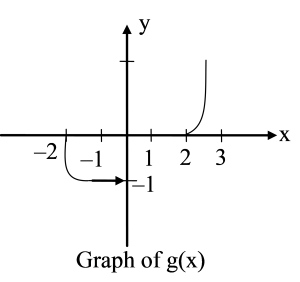Question
Question: For (x) = x<sup>2</sup> – 2 \|x\|, test the continuity and differentiability of g(x) in the interva...
For (x) = x2 – 2 |x|, test the continuity and differentiability of g(x) in the interval [-2, 3], where
g (x) =f(x)=sinxx32xcosxx21tanxx1, are –
g (x) is continuous and differentiable everywhere except
x = 0
g (x) is non-differentiable at x = 0 and 2
g (x) is non-differentiable at x = 0, 1, 2
None of the above
g (x) is non-differentiable at x = 0 and 2
Solution
- (2)
Sol. Here (x) = ⎩⎨⎧x2+2x,0,x2−2x,x<0x=0x>0
Case 1 : –2 ≤ x < –1, (x) decreases ⇒ g (x) = x2 + 2x
Case 2 : –1 ≤ x < 0, (x) increases ⇒ g (x) = –1
Case 3 : 0 ≤ x < 1, (x) decreases ⇒ g(x) = 0
Case 4 : 1 ≤ x < 2, (x) increases but (x) < 0
⇒ g (x) = (0) = 0
Case 5 : 2 ≤ x ≤ 3, (x) increases and (x) ≥ 0
∀ x ∈ [2, 3)
⇒ g (x) = (x) = x2 – 2x, 2 ≤ x ≤ 3

Therefore g (x) = 
Clearly g (x) is continuous everywhere except at x = 0.
Also g (x) is non differentiable at x = 0 and 2.
Hence (2) is the correct answer.
